Invasive Species: Alhagi maurorum, Camelthorn
Camelthorn is an invasive perennial shrub that grows 2 to 3 ft. (0.6 to 0.9 m) tall. The simple, entire leaves are oval to lance shaped and are alternate along the stem. Small, pealike flowers are produced in June to August. These brown to maroon flowers extend from sharp, yellow spines that are 1 to 2 in. (2.5 to 5 cm) in length and located along the rigid branches. Seedpods are constricted between the individual reddish brown to tan seeds and are tipped with small beaks. Camelthorn spreads mainly from rhizomes. Camelthorn is found in arid, agricultural areas and riverbanks of the Western United States, where it has access to water during the growing season. The plant rapidly colonizes an area by producing new plants from its creeping roots. It is native to the Mediterranean region and western Asia and was introduced to the United States in the early 1900s as a contaminant in alfalfa seed. It is listed as a noxious weed in several Western states.
What are invasive species, and why should we be concerned about them?
Taxonomy: Scientific and Common Names for This Species
Fabales > Fabaceae > Alhagi maurorum Medik.
Synonym(s): none
Alhagi maurorum – USDA PLANTS Profile
Distribution Maps
camelthorn – The reported distribution of this invasive species across the United States (Source: Invasive Plant Atlas of the United States)
Up-to-the-minute distribution maps and why they are important
Reporting This Invasive Species
What is the best way to report the occurrence of an invasive species?
How to report an invasive species sighting to EDDMapS – Early Detection & Distribution Mapping System
EDDMapS – Report an invasive species to EDDMapS.
County Extension Offices – Find your county Extension office on this map provided by USDA.
How to Identify
This invasive species can be identified by looking for the characteristics described in the paragraphs that follow.
Shrub
Camelthorn is a perennial shrub that grows 2 to 3 ft. (0.6 to 0.9 m) tall.
 |
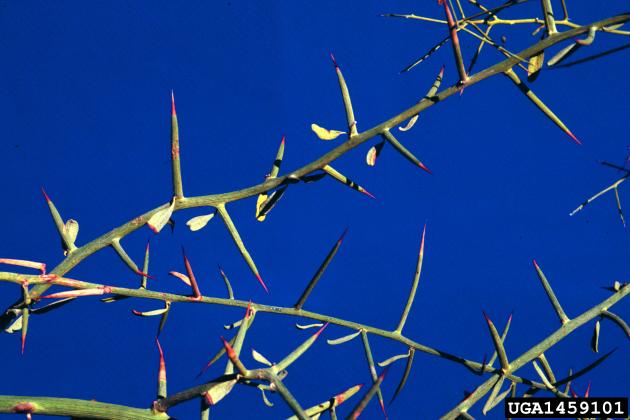
|
|
John M. Randall,, The Nature Conservancy, bugwood.org |
Steve Dewey, Utah State University, bugwood.org |
Foliage
The simple, entire leaves are oval to lance shaped and are alternate along the stem.
 |
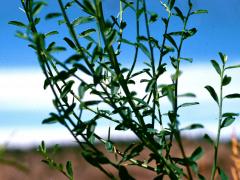 |
| Steve Dewey, Utah State University, bugwood.org | Steve Dewey, Utah State University, bugwood.org |
Flower
Small, pealike flowers are produced in June to August. These brown to maroon flowers extend from sharp, yellow spines that are 1 to 2 in. (2.5 to 5 cm) in length and located along the rigid branches.
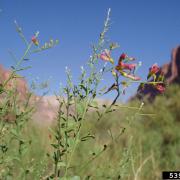 |
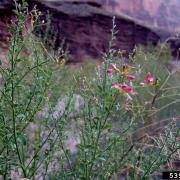 |
|
John M. Randall, The Nature Conservancy, |
John M. Randall, The Nature Conservancy, bugwood.org |
Fruit
Seedpods are constricted between the individual reddish brown to tan seeds and are tipped with small beaks. Camelthorn spreads mainly from rhizomes.
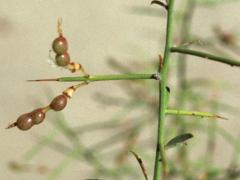 |
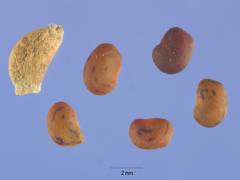 |
| John M. Randall, The Nature Conservancy, bugwood.org | Steve Hurst, USDA NRCS PLANTS Database, bugwood.org |
Native Species That Resemble Camelthorn
Parkinsonia aculeata, Mexican palo-verde – Images at invasive.org
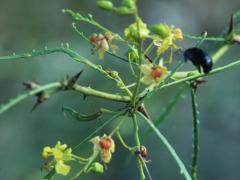 |
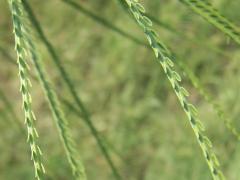 |
| Joy Viola, Northeastern University, bugwood.org | Karan A. Rawlins, University of Georgia, bugwood.org |
– Images at invasive.org
| bugwood.org | bugwood.org |
Additional Images for Camelthorn
camelthorn – Images at invasive.org
Learning Resources for Camelthorn
Additional Information, Biology, Control and Management Resources
Control and management recommendations vary according to individual circumstances. Location, habitat, weather, and a variety of other conditions are factors that help determine the best treatment choice. To find the safest and most effective treatment for your situation, consult your state’s land-grant institution. If you will use chemicals as part of the control process, always refer to the product label.
United States Land Grant University System – Find your Land Grant University’s College of Agriculture, University Cooperative Extension Service, or other related partner on this map provided by USDA.
Plant profiles – California Invasive Plant Council
Invasives Database – TexasInvasives.org
Invasive Species Compendium (Beta) – cabi.org
Encycloweedia: Data Sheets – California Department of Food and Agriculture
Noxious Weed List – Washington State Noxious Weed Control Board
